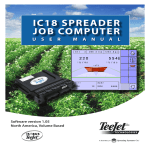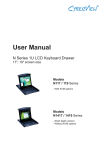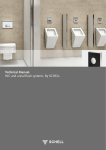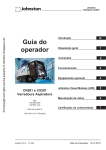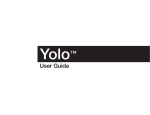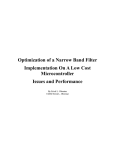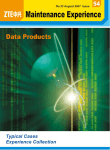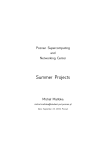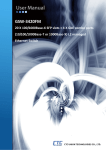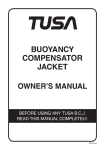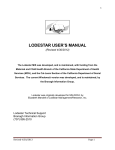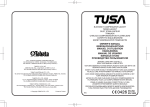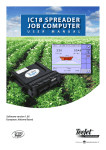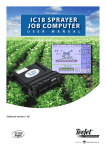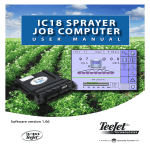Download Safety of High Pressure Cleaners
Transcript
Manufacturing Summit PPS-sre / Safety_of_High_Pressure_Cleaners_AK-BR.ppt / Manufacturing Summit CETA Technical Committee Activities for 2014 • Received Pressure Washer Exemption for San Joaquin Valley Air Pollution Control District under Rule 4308 • Applied for exemption status for Yolo-Solano Air Management District under Rule 2.37 Natural Gas-Fired Water Heaters and Small Boilers • Completed a new CETA Performance Standard with signature approval • Completed a CETA Efficiency Standard final draft for final approval • Started a CETA Ergonomic High Pressure Spray gun standard • Completed a draft of a CETA High Pressure Hose Standard • Contacted the DOE to start lobbying for our CETA Efficiency Standard CMB-S-rie / Titelmotive_KMAD / 02.12.2011 2 CETA Technical Committee Report Good Afternoon Dr. Dean, I was the project lead for the November 2013 amendment to District Rule 4308 so I can answer your question below. As proposed in the draft staff report you attached, our Governing Board did adopt an exemption for all hot water pressure washers during this recent rule amendment. Attached is the final rule, which can also be found on our District webpage here: http://www.valleyair.org/rules/currntrules/034308_CleanRule.pdf. In addition, attached is the final draft staff report with analyses that we took to our Governing Board for adoption. That can also be found on our webpage here: http://www.valleyair.org/Board_meetings/GB/agenda_minutes/Agenda/2013/November/8FinalGBItem_Rule4308_11.14.13.pdf Let me know if you have any additional questions. Thank you. Chelsea Gonzales Air Quality Specialist San Joaquin Valley Air Pollution Control District CETA Technical Committee Report Reason for having an industry standard Performance Standard CPC 100 There has been reported tort claims against companies which advertise specifications which are not delivered when tested by the customer. This is false advertisement. A class action lawsuit in California involving small engine manufactures several years ago forced the engine industry to examine the various engine J standards and the difficulty of not having a single performance standard which is recognized by the industry. CETA is attempting to raise the bar for manufacturers giving the pressure washer industry a performance standard which was developed by the industry. This standard uses the same procedures as the old standard for testing and measuring gpm and psi with the biggest change in calculating engine performance. Engines are measured by acceptable loading on the engine and is defined by using no more than 85% of maximum available engine power. By solving for the difference in “loaded” and “wide open throttle” speeds, using a typical loaded speed of 3200 rpm and 85% load, about 175 rpm difference is determined. The engine manufacturers are performing this test to verify excessive loading on their engines which could void engine warranties Market Efficiency Labeling Efficiency Label Recent studies show that consumers continue to support companies and brands that demonstrate social and environmental responsibility and are increasingly looking for certification marks or labels on products to validate environmental credentials. What's more, manufacturers and retail brands are under greater pressure to ensure products meet standards and have accurate test and analysis data to back up their claims. Intertek's new Green Leaf Mark is proof that a product has been independently tested and found to conform to multiple existing environmental regulations, such as RoHS laws, REACH and Eco Design requirements through one mark rather than multiple marks. The Green Leaf Mark is used on product packaging, in point of purchase displays, product advertising and literature to explain a product’s environmental credentials. Efficiency Standard CETA-ES01 • This standard was written to address the requirement by the DOE standard 10 CFR Part 430 • The plan is to use this standard for the application and use of the Green Leaf label, verified label or creation of a CETA efficiency label. • The present industry average using this standard is 70% efficiency. • It is proposed that the target will be 68% efficiency which meets the requirement of only 25% able to comply with this standard giving importance to the use of an efficiency label. We still need feedback from the various pressure washer manufacturers to determine their averages following this standard before establishing a final number. This is the same requirement for use of the ENERGY STAR label. The use of these labels are limited to only 25% of the products that can achieve targeted efficiency. Current Laws & Standards Efficiencies & Regulations: •Federal Level: 78% (AFUE Standard) •CO in flue gas <400ppm •Smoke test #3 on the smoke spot •The EUnited Cleaning Machines Association requires on a voluntary bases any machine greater then 50KW (170,800 Btu’s) can not have a thermal loss of greater then 9% as measured using the carbon dioxide content or oxygen measurement in the exhaust. Future Laws & Regulations WASHINGTON, DC - The U.S. Department of Energy (DOE) recently announced it has increased the energy efficiency standards for process heaters and boilers. The Department amended these standards, which become effective in 2015. The minimum AFUE rating requirements vary based on the type of fuel used and the heating medium. The minimum AFUE rating for a gas-fired hot water process heaters and boilers is 82%; the minimum AFUE rating for an oil-fired hot water process heater and boiler is 84%. In addition, gas-fired process heaters and boilers are not permitted to have a constant burning pilot.In 2020 the ENERG is going to make mandatory EU-wide 9% thermal energy loss in exhaust gas on machines over 170,800 btu’s ENERGY STAR Program The EPA developed a program of selected products which they feel have a significant potential for energy savings and greenhouse gas reductions. Presently there is a category for boilers which does not fit our industry. We need to lobby to establish a category. The ENERGY STAR mark can convey a marketing advantage which requires the following during the selection process: • Significant potential energy savings and greenhouse gas reductions • Product must be fully commercialized and available to the public • Manufactures have the ability to produce similar products that qualify for ENERGY STAR • Clear method of distinction between products that are more efficient and those that are less efficient Ergonomic Spray Gun Standard We have received several requests from different insurance companies as an association to develop an industry ergonomic high pressure spray gun standard. This will require detailed research to determine fatigue and stress related injury data while using pressure washer equipment. The Ergonomic standard can convey a bench mark for spray gun manufacturers: • Significant reduction in workman compensation claims • Specify time of use from force measured • Manufactures have the ability to produce better quality spray guns using different design changes to reduce fatigue Should incorporate tension, balance and weight distribution. The force to open the trigger gun is 105N (24 lb), at a pressure of 240 bar (3500 psi). Force to hold the trigger gun in the open position is 30N (8 lb), at a pressure of 150 bar (2200 psi). • N= Newton General – Why do we need safety standards? To avoid accidents with unsafe products! Compliance with standard requirements helps to reduce litigation of products placed on the market Application of standards is also relevant for the liability insurance in a company Knowledge of the content of important standards is a must-have for all persons involved in the engineering process of a product (designers, lab technicians…) Product safety is vital for any company with the testing and certification of one their products – it has to be implemented as a company policy Product certification is partly mandatory or a marketing advantage PPS-sre / Safety_of_High_Pressure_Cleaners_AK-BR.ppt / Certification worldwide (el. products) Mandatory Recommended Regions w/ increasing mandatory certification IEC vs. CENELEC standards IEC publishes standards on a worldwide basis IEC standards form the basis for european standards published by CENELEC Only if a EU directive (Machinery, EMC, Low Voltage…) require additional or different requirements, CENELEC will amend or modify the IEC content in so-called “Common modifications”. Additional modifications are based on national laws. Typical requirement: Plugs are different in nearly all countries. US: UL has its own standard (like UL 1776) but is starting to adopt IEC standards Canada: CSA has its own standards (C22.2 No. 68 & B140.11) but has in parallel a hug variety of IEC standards already adopted PPS-sre / Safety_of_High_Pressure_Cleaners_AK-BR.ppt / General – IEC / EN 60335 IEC / EN 60335-Family is a standard family dealing with safety Performance or environmental requirements are not dealt within IEC / EN 60335 But there are some overlaps; oil fired high pressure cleaners – safety standard specifies max. soot and CO emissions due to safety relevance) product safety has to be ensured during • • • product safety standards will not give protection against • • normal operation (intended use, described in user instructions) typically forseeable misuse single failure cases (safe when one failure occurs, functionality and or product may be damaged) multiple failures misuse High Pressure Cleaners • • typically forseeable misuse: cleaning the enclosure with high pressure water spray misuse: spraying paint instead of water PPS-sre / Safety_of_High_Pressure_Cleaners_AK-BR.ppt / Relation IEC / EN 60335 part 1 and Part 2-x Part 1 has to be seen as a library, as a collection of safety standards and test procedures Part 2-x specifies specific requirements by referencing on certain contents of part 1 or by specifying new requirements PPS-sre / Safety_of_High_Pressure_Cleaners_AK-BR.ppt / Relation IEC / EN 60335 Part 1 and Part 2-x Part 2-x is always the starting point for research on requirements, not part 1! Part 1 can not be used independently! Part 1 and Part 2-x have the same structure (numbering of clauses etc). Part 2-x specifies the application of part 1 clause by clause: • “This clause of Part 1 is replaced by the following” => The relevant content of part 1 is not needed, everything is specified in part 2-x • “This clause of Part 1 is applicable” => The relevant content of part 1 is completely to be used, no additions or deletions necessary • “This clause of Part 1 is applicable except as follows” “Modification”, ”Addition”,”Replacement”, => The relevant content of part 1 is completely to be used, however, the content has to be modified as specified • “This clause of Part 1 is not applicable” => This clause of part 1 is not needed. PPS-sre / Safety_of_High_Pressure_Cleaners_AK-BR.ppt / Normative vs. informative Content / Structure The content of a standard is mandatory, except for • “NOTE”: This text contains no requirements, only explanations or examples A lot of former “NOTES” have been made normative during the last revisions of the standards • informative Annex (= a very long NOTE) Each Clauses is divided in two resp. three parts • Requirement (“What has to be ensured?”) • Test (“How to measure/ inspect?”) – always in Italics • maybe acceptance criteria at the end: Requirement fulfilled yes/no (“what is acceptable during or after the test, what’s not?”) – always in Italics PPS-sre / Safety_of_High_Pressure_Cleaners_AK-BR.ppt / IEC / EN 60335-Family / Overview • IEC / EN 60335-1 General Requirements • IEC / EN 60335-2-2 Vacuum Cleaners • IEC / EN 60335-2-10 Sweepers • IEC / EN 60335-2-29 Battery chargers • IEC / EN 60335-2-41 Garden pumps / submersible pumps • IEC / EN 60335-2-54 steam cleaners • IEC / EN 60335-2-67 Single-Disc-Machines Professional • IEC / EN 60335-2-68 Spray Extractors Professional • IEC / EN 60335-2-69 Vacuum Cleaners Professional • IEC / EN 60335-2-72 Scrubber driers / sweepers Professional • IEC / EN 60335-2-75 vending machines (water dispensers) • IEC / EN 60335-2-80 Fans / Blowers(AB84) • IEC / EN 60335-2-79 High Pressure Cleaners • IEC / EN 60335-2-102 Additional requirements for oil- and gas fired products like water heaters and boilers • IEC / EN 60335-1 contains general and basic requirements • IEC / EN 60335-2-x contains product specific requirements PPS-sre / Safety_of_High_Pressure_Cleaners_AK-BR.ppt / Structure of 60335 - standards (part 1) 1 Scope 2 Normative references 3 Terms and Definitions 4 General Requirement 5 General Conditions for the test 6 Classification 7 Marking and instructions 8 Protection against access to live parts 9 Starting of motor operated appliances 10 Power input and current 11 Heating 12 Void 13 Leakage Current and electric strength at operating temperature 14 Transient overvoltages 15 Moisture resistance - is this standard applicable? - Definition of important terms, bold print - protection classes, IP-classification - rating plate, symbols, content of user manual - test probes, access to electrical components - Tolerances for power values (real <=> rating plate) - Temperature rise measurement for components and surfaces - IP-Test, overflow test, climate chamber PPS-sre / Safety_of_High_Pressure_Cleaners_AK-BR.ppt / Structure of 60335 - standards (part 2) 16 Leakage current and electric strength 17 Overload protection of transformers and associated circuits 18 Endurance 19 Abnormal operation - dielectric strength test etc. - 96h Test - locked rotor tests, functional safety, protection components 20 Stability and mech. hazards - tilt tests, test probes for mech. components 21 Mechanical strength - hammer tests of enclosures 22 Construction - various mech. and el. requirements 23 Internal wiring - Quality of internal cables and wires 24 Components - Requirements for el. components 25 Supply connection and ext. flexible cords - Supply Cord: Length, Quality, strain relief 26 Terminals for external conductors 27 Provisions for earthing 28 Screws and connections - Endurance of screw connections 29 Clearances, creepage distances - Min. distances of electrical parts through and solid insulation air or over surface 30 Resistance to heat and fire - Ball pressure test and glow wire tests. Classify attended vs. unattended appliances 31 Resistance to rusting 32 Radiation, toxicity and similar hazards - Reference to EMF tests PPS-sre / Safety_of_High_Pressure_Cleaners_AK-BR.ppt / Important Content – Scope Pressure range: 360 psi (25 bar) to 5000 psi (350 bar) • Upper pressure limit harmonized with north american standard UL 1776 (Type III) • In Europe, high pressure cleaners exceeding 5000 psi (350 bar) are covered by EN 1829-1 Energy system • Electrical • battery driven • internal combustion engine driven PPS-sre / Safety_of_High_Pressure_Cleaners_AK-BR.ppt / Cl. 6 Classification Cl. 6.1 Protection class Defined in (IEC / EN 60335-2-x). • Class I grounded • Class ll double insulated • Class III low voltage (marking not yet mandatory) However, hand-held appliances and hand-held parts of steam cleaners and high pressure cleaners shall be class II or class III. Cl. 6.2 Protection degree against ingess of water Defined in (IEC / EN 60335-2-x). PPS-sre / Safety_of_High_Pressure_Cleaners_AK-BR.ppt / Cl. 6.1 Classification protection class conductive metal enclosure dangerous touchable voltage > 42V L N protection Class I isolating plastic or sufficiently separated metal enclosure protection Class II L N dangerous touchable voltage > 42V Protection Class III: U<42V (not dangerous) = Safety extra low voltage (SELV) PPS-sre / Safety_of_High_Pressure_Cleaners_AK-BR.ppt / § 15 Moisture resistance Enclosure must comply with the classified IP code of Cl. 6.2 • High Pressure Cleaners: IPX5 (Protected against water jets - Water projected at all angles through a 6.3mm nozzle at a flow rate of 3.3 gpm (12.5 liters/min) at a pressure of 4.35 psi (30 kN/m2) for 3 minutes from a distance of 118” (3 meters) • Dry Vacs and scrubbers for dry use: IPX0 • Wet & Dry Vacs, Single Disc Machines, scrubbers for wet use, Garden pumps: IPX4 • Submersible pumps: IPX8 PPS-sre / Safety_of_High_Pressure_Cleaners_AK-BR.ppt / § 15 Moisture Resistance IP protection acc. IEC 60529: 0 1 2 3 4 5 6 7 8 no protection protection against straight water drops protection against dropping water if enclosure is tilt up to 15° protection against spraying water max. 60° out of the vertical axis protection against spraying water out of all directions (angles maybe limited by certain parts 2) protection against splashing water (out of a nozzle) protection against strong splashing water protection against temporarily submersion protection against permanent submersion PPS-sre / Safety_of_High_Pressure_Cleaners_AK-BR.ppt / § 15.1 IP-Testing Testing according Cl. 15.1.1 except IPX0 (no test) done like described in IEC 60529. IPX3 / IPX4 for small products performed with a semi-circular spray bar and with a mobile spray nozzle head for large products IPX3: max. +/- 60° Tilting against the vertical plane IPX4: max +/- 90° or +/- 180° Tilting against the vertical plane IPX5: Splashing water nozzle IP-testing performed with appliance switch off Detachable parts are opened or removed except for covers necessary to be opened or removed for user maintenance and if a tool is needed. Acceptance criteria after the test: 1. 2. Passing a dielectric strength test acc. Cl. 16.3 Visual check of clearances and creepage distances after dismantling: No traces of liquid should reduce the minimum values of Cl. 29. Products with liquid tanks (e.g. detergent tanks): Tank will be filled completely + 15% or 0,25l whatever is the greater within a minute. Acceptance criteria: Passing dielectric strength afterwards. PPS-sre / Safety_of_High_Pressure_Cleaners_AK-BR.ppt / § 15 Spray arch Spray arch (IPX3 / IPX4) PPS-sre / Safety_of_High_Pressure_Cleaners_AK-BR.ppt / § 15 Spray arch PPS-sre / Safety_of_High_Pressure_Cleaners_AK-BR.ppt / § 15 Test nozzle Hand nozzle for IPX3 / IPX4 Splashing water nozzle for IPX5 PPS-sre / Safety_of_High_Pressure_Cleaners_AK-BR.ppt / § 8.1 Protection against access to live parts General: durable fixing of electrical components “free flying” wiring should be avoided detachable parts are removed various test probes • Probe B of IEC 61032 for Class I (Simulation of a long thin index finger) • Probe 13 of IEC 61032 for Class II (Total appliance & details of Cl. II products) Length of tip: 15mm For vulnerable people also Probe 18 (Europe only) PPS-sre / Safety_of_High_Pressure_Cleaners_AK-BR.ppt / Tolerances acc. IEC/EN 60335-2-79 / Rating plate / Cl. 7.1(.x) rated power input Tolerance +15% or 60W, (whichever is the greater) allowable pressure 1,1x - 1,5x rated pressure rated pressure Tolerance +/-10% in hp mode rated flow measured in hp mode, no tolerances defined max. flow rate measured in detergent mode with detergent nozzle, includes amount of detergent, Tolerance +/-10% General rules for all tolerances: Values on the rating plate are the starting point for all tolerances mentioned. PPS-sre / Safety_of_High_Pressure_Cleaners_AK-BR.ppt / Important Content – rating plate (Cl. 7.1) Serial number is not mandatory Complete address of manufacturer (to be reached by mail) TOW (typical operation weight) shall appear on rating plate: The weight of the machine ready for operation in lb/kg, rounded to one decimal place, including • with cable/cord (not relevant for cordless machines); with batteries (not relevant for hard wired connected • machines); • with all standard equipment necessary for normal use: Hose, Spraying device, Standard nozzle (but no extra nozzles), machine and hoses completely empty, fuel tank filled, tank for descaling detergent is filled, tank for cleaning agent, where applicable, is not filled “Designation of machinery” & “designation of series or type” • Original intent of the EU Com was that a drilling machine should be marked with “drilling machine” due to difficulties of the market surveillance officers to identify the purpose of some machines • The official wording in the machinery directive (MD) (Annex 1, Cl. 1.7.3) is much stricter, but weakened by the official Guideline to the MD. • Original intend of the EN version of standard transferred into the IEC standards Year of production • Year when the production process was finished • High Pressure Accessories no longer need a marking / symbol of manufacturer (relevant for OEM products) PPS-sre / Safety_of_High_Pressure_Cleaners_AK-BR.ppt / Additional markings General warning sticker for all machines Products not equipped with back flow prevention LPG engine driven products intended for indoor use PPS-sre / Safety_of_High_Pressure_Cleaners_AK-BR.ppt / Important Content – User manual (Cl. 7.12) Language versions verified by the manufacturer need to be marked with “Original instructions” Other versions (e.g. translations created by a dealer) need to be marked with “Translation of the original instructions” Technical data: Content of the rating plate need to be shown in the instructions Explanation of all symbols used on the machine Clear identification of intended use, typical cases of foreseeable misuse information regarding putting into service, safer operation, handling, transportation, and storage conditions in which the machine meets the requirement of stability during use, transportation, assembly, dismantling, when out of service, testing or foreseeable breakdowns Safety warnings now clearly separated into Warning, Caution, Danger (input from ANSI Z535 series) Important content – User manual (Noise & Vibration) User manual – Noise (Cl. 7.12.102 / Annex CC) & Vibration (Cl. 7.12.103 / Annex DD) Noise • Noise measurement according Annex CC (harmonised with EN 1829-1) • sound pressure level shall be given as a dual number value (value + uncertainty separately) • sound power level shall be given as a single number value (value including uncertainty) • Reference to the test standard used (=> IEC 60335-2-79) has to be stated • Measurement & statement in instruction is not mandatory for non-EU countries Vibration • • • • • • Vibration measurement according to Annex DD Measurement of hand-arm acceleration or whole-body-vibration If measurement is below 2.5m/s² resp. 0.5 m/s², this has to be stated Reference to the test standard used (=> IEC 60335-2-79) has to be stated Uncertainty of measurement has to stated Measurement & statement in instruction is not mandatory for non-EU countries § 10 Power input and current Starting point of all evaluations is always the rated value (rated input power, rated current) as marked on the rating plate – measured at rated voltage Attention: Solenoid valves and reciprocating plunger type pumps change a heating appliance into a combined appliance For motor-operated appliances (like high pressure cleaners), tolerances are mostly single-sided only, causing the fact that the value on the rating plate can be underrun in reality Marked values of rated input power are typical for Europe, values for rated current are typical for (North-) America § 11 Heating Measurement to be performed with fine thermocouples or (usual for windings) by the rise-of-reasistance-method. RoR is perferred, whereever possible. Heating measurements are always expressed as relative temperature rises ΔT (max. temperature – starting temperature), not as absolute values! Measurements are performed until stable conditions are established (stable is not defined!) – take care: some products get hotter after switching off Operating conditions (supply voltages ) according to type of product (§11.4 – 11.6): • • • Heating appliances: Two measurements: 100% und 115% of rated voltage Combined appliances or motor-operated appliances: most unfavorable voltage within the range of 94% – 106% of rated voltage Attention: Products with a supply voltage range („220-240V“) are operated with a combination of extreme voltages and factors: 0.94*220V – 1.06*240V => 206 – 254V § 11 Heating of windings Windings (e.g. motors, but also coils of solenoid valves) are classified in insulation classes acc. IEC 60085– different insulation classes allow lead to different temperature limits During the selection of a component a declaration of insulation, issued by the manufacturer has to be supplied Otherwise there is no change to test and evaluate against the correct limit Remark: Insulation classes with classification letters („A“) have been replace by numbers („Class 105“) § 11 Heating of components Various components (swítches, supply cords, capacitors) are available with or without a „T“-marking – this marking shows the acceptable limits of the surrounding area within 5mm distance to the component surface Without T-marking: More stringent limits § 11 Heating: Enclosure (not handles) Temperature limits for surfaces of enclosures differ actually between IEC and EN 60335. The scope was broadened to cover „vulnerable people“ (disabled, elderly people or children) leading to reduced surface temperature limits acc. CENELEC Guide 29 – this will be implemented into IEC 60335-1 Edition 5.1 or 5.2 (drafts currently under voted). Proposed values: Auszug aus der künftigen EN 60335-1: § 11 Heating of handles, grips and knobs Handles are classified into two groups • Continously used (e.g. Trigger gun of a high pressure cleaner) • Short term use (e.g. switch knob for operation modes): § 13 / §16 Leakage current (§13 warm / §16 cold) Leakage current exist for technical reasons could not be avoided. They are generated due to limited resistances of insulation materials like cords and cables, terminals, also Y-capacitors (rfi-filters) for EMC-reasons. These leakage currents flow through the enclosure and the ground connection back to the supply system – or to a person touching the enclosure (=>measurment with a 20 x 10cm aluminum foil around a plastic enclosure) § 13 / §16 Dielectric voltage withstand (§13 warm / §16 cold) Dielectric voltage withstand tests (also called HiPot-tests) are used to check the quality of the electrical insulation Application of a high voltage for 60s between the combined supply connections (phase+neutral) and touchable metal parts (PE) or the insulating enclosure. 230Vappliances Prot. Class I Prot. Class II Cl. 20 Stability / Cl. 21 Mechanical Strength Stability • All accessories in their intended position • Place high pressure cleaner in the worst position on an incline of 10° • No tip over Mechanical Strength • Spring hammer test on all enclosure parts with 1J • Afterwards application of test probe B Hydrostatic pressure test • 2x rated pressure complete system • 4x high pressure hose (next edition: only for high pressure hoses outside of the pressure washer) Safety valve / Pressure relief valve / Bypass valve • Pressure is increased to 1,1x allowable pressure: Component must act (Additional requirements for steam producing hot water high pressure cleaners) PPS-sre / Safety_of_High_Pressure_Cleaners_AK-BR.ppt / Important content – Mechanical Strength (Cl. 21Z101) Allowable pressure shall not exceed 1.5 times rated pressure. This requirement was moved from Cl. 10.101 – and due to the effective date of the new standard no transition period is available Indirect limitation of “max. pressure” marketing values! Cl. 22 Construction / Cl. 24 Components No openings from underneath in the enclosure up to 60mm that could allow access to electrical parts (“puddle test”) Drain hole openings: Circular openings: min diameter 5mm or area not less than 30 mm², the width not being less than 3 mm Trigger gun: No locking in the opening position, locking must be in the closed position (“children protection”). Trigger shall be protected from unintended actuation (mech. protector around trigger), Locking mechanism is tested with a load of 150N actuation force. Trigger endurance: Test for 50.000 cycles und high pressure. Minimum length of spray lance: Nozzle – trigger min. 750mm distance if used with a pencil jet nozzle (0°C incl. rotary nozzles) PPS-sre / Safety_of_High_Pressure_Cleaners_AK-BR.ppt / Important Content – Guards (Cl. 22.111) Guard is a new defined term: part of the machine specifically designed to provide protection by means of a physical barrier Fixing systems shall remain attached to the guards or to the machine when the guards are removed, with the exception of fixing systems than can remain detachable without impairing safety This does not apply if, after removal of the screws, or if the component is incorrectly repositioned, the machine becomes inoperative or is obviously incomplete. Enclosures are not regarded as guards. Additional help out of the draft guideline to the MD: For the same reason, it may not be necessary to apply the requirement to the casings of machinery intended for use by consumers, when the design of the fixing system and the manufacturer's instructions restrict to a specialist repair workshop any repairs that may require the guards to be removed. Important Content – Guards (Cl. 22.111) MUFFLER PROTECTOR TAPPING SCREW Guard from Hot parts Guard from Hot parts TAPPING SCREW LOWER PROTECTOR Important Content – Low pressure accessories (Cl. 22.110 & PPE (Cl. 22.113) Low Pressure Accessories need a nozzle size > 2mm: Old requirement formerly located in Cl. 3.117 If Personal Protection Equipment (PPE) is necessary for the safe use of products, all controls shall be designed to be operated safely with the PPE Example: A high pressure washer maybe used with gloves as PPE. All controls need to be designed in a way to be operated safely while the operator wears gloves! Mechanical Endurance – Screws (Cl. 28) Screwed Joints have to be tested if they are tightened • • during user maintenance (not repair by a specialist) or during replacement of a supply cord (type X) Screwed Joints have to be tested if they are used for electrical connections (normally no problem) Test: Tighten and loosening of connection • • 10 times for screws in engagement with a thread of insulating material 5 times for nuts or other screws with a torque for standard metal screws of Acceptance criteria: Screwed joint still capable to hold this torque Ref. Cl. 28.1 Protection against crushing / cutting – ISO 13857 Upper limbs Protection against crushing / cutting – EN 349 (1) Values should be used as a guide for manually operated parts (like handles), depending on the risk (-> weight) Corresponding ISO-standard in preparation Part Body Head Leg Foot Minimum distance in mm Protection against crushing / cutting – EN 349 (2) Toe Arm Hand, Wrist, Fist Finger Electrical Requirements – Components (1) General • components must comply with the relevant IEC-standard for this component category acc. Cl. 24 • component should be tested and certified by a accredited 3rd party lab: VDE / ENEC, UL, CSA, … - certificate shall refer to the correct standard • a lot of component manufacturers certify for both worlds and have double marking, e.g. “120V UL” + “250V VDE” • sometimes optional “checked in the appliance”, typically used if component is used not within scope of certification/specs (higher load, hotter ambient temperature, exceeding nominal cycles of operation) Electrical Requirements – Components (2) Switches • Main switch for 230V machines: all-pole disconnection • all switches: endurance test: frequently used: 50.000 operation cycles (typical marking “5E4” = 5 * 104) -> main switch, operator presence control etc. others: 10.000 operation cycles (typical marking “1E4” = 1 * 104) -> operation mode switches, drive directions • relevant standard IEC / EN 61058-1 • optional “checked in the appliance”: switch not certified by manufacturer or used not within specs (e.g. higher load) • check for ambient temperature rating (“T-marking”) • Ref.: Cl. 22.105, 24.1.3 Electrical Requirements – Components (3) Other controls • relevant standard IEC / EN 60730-standard series • endurance requirements thermostats 10.000 cycles temperature limiters 1.000 cycles self-resetting thermal cut-outs 300 cycles voltage-maintained non-self-resetting thermal cut-outs 1.000 cycles other non-self-resetting thermal cut-outs 30 cycles • Ref. Cl. 24.1.4 Electrical Requirements – Components (4) Transformers • • • • relevant standard IEC / EN 61558-2-6 double insulation between primary and secondary winding secondary voltage: less than 42 V -> SELV (safety-extra low-voltage) Relevant standard for ignition transformer IEC / EN 61558-2-3 • Ref. Cl. 24.1.2 Receptacles / connectors for accessories • relevant standard IEC 60320-standards family • Ref. Cl. 24.1.5 Cl. 25 Supply connection and external flexible cords Products must be fitted with a supply cord (except 3AC products and machines for fixed installation) Quality (for Brazil it is slightly different – type designation is different) • PVC: 60227 IEC 53 (H05VV-F) for home&garden products • Heavy rubber sheathed: 60245 IEC 57 (H05RN-F) for home&garden products • Heavy rubber sheathed: 60245 IEC 66 (H07RN-F) for professional products Length: Mobile machines need 5m of length available to the user Strain relief and flexing test: push force 125N, 25 times; 0,4 Nm for 1 min, flexing on the test bench (10.000 cycles +/- 45°) Plug: 1AC machines need to be equipped with a plug; 3AC machines not PPS-sre / Safety_of_High_Pressure_Cleaners_AK-BR.ppt / Cl. 25 Supply connection and external flexible cords PPS-sre / Safety_of_High_Pressure_Cleaners_AK-BR.ppt / Clearances of electrical insulation (1) – Ref. Cl. 29.1 IEC term “clearance” = UL term “spacing through air” Examples: Mains supplied 230V / Battery supplied 24V Cat. II Determination of Overvoltage Category Annex K 2500V 1,5mm Cat. II 230V Determination of rated voltage Typeplate! Determination of Rated Impulse Voltage Table 15 500V Determination of min. clearance Table 16 0,5mm 24V § 29.1 Clearances Min. clearances acc. Tabelle 16 = clearance of basic insulation = clearance of supplementary insulation clearance of reinforced insulation: Table 16 - use value of next higher step of rated impulse voltage or if below(only for „rigid“ parts) Surge-Test acc. § 14 To be below is not accepted! To be below is not accepted! § 29.2 creepage distances Determination of pollution degree (often 2) Annex M creepage distance for basic insulation is never below than clearance for basic insulation! Working voltage Determination of material group CTI-Index or PTI-value acc.Annex N Determination of creepage distance for basic insulation Table 17 § 14 Surge-Test! Determination of creepage distance for functional insulation Table 18 Supplementary insulation = basic insulation reinforced insulation = 2x basic insulation Clearances of electrical insulation (2) Creepage distances of el. insulation (1) – Ref. Cl. 29.2 Table 17 with input of: Working voltage (example 240V, 24V) Pollution degree = 2, exemption: Pollution degree = 1 if special protection is applied (encapsulated pcb…) Pollution degree = 3 if conductive dust occurs (dust of carbon brushes…) Material group: CTI – Comparative Tracking Index I, II, IIIa/b Preselection research for CTI possible: UL IQ Plastics Database Result: min. creepage distance • for basic or supplementary insulation: 2,5mm / 1,2 mm • for reinforced insulation: 5,0 mm / 2,4 mm (2x basic ins.) Example for evaluation of clearances (Figure 11) Cl. 30 Resistance to heat and fire Ball Pressure Test (1) Test of external parts, insulation parts Test on plastic softening Preselection research possible: UL IQ Plastics Database Ref. Cl. 30.1, Annex O PPS-sre / Safety_of_High_Pressure_Cleaners_AK-BR.ppt / Cl. 30 Resistance to heat and fire Ball Pressure Test (2) Ref. Cl. 30.1, Annex O PPS-sre / Safety_of_High_Pressure_Cleaners_AK-BR.ppt / Cl. 30 Resistance to heat and fire Glow Wire Test (1) Test on flammability w/ various temperatures: • Standard 550°C -> uncritical • attended, connection <= 0,5 A: 650°C • attended, for connections > 0,5 A: 750°C -> ambitious, often UL 94 V0 necessary • High pressure cleaners are regarded as attended Connection: plastic part around a currentcarrying connection and its surrounding within 3mm distance. Connections are: crimped, rely on spring load etc. Connections are not welded etc. Preselection research possible: UL IQ Plastics Database IEC/EN 60335-1 requirements supersede component standard requirements! Components maybe have to be retested! Ref. Cl. 30.2, Annex O PPS-sre / Safety_of_High_Pressure_Cleaners_AK-BR.ppt / Cl. 30 Resistance to heat and fire Glow Wire Test (1) PPS-sre / Safety_of_High_Pressure_Cleaners_AK-BR.ppt / Cl. 30 Resistance to heat and fire Glow Wire Test (3) attended: nearly all products unattended: battery charger & areas involved in charging process PPS-sre / Safety_of_High_Pressure_Cleaners_AK-BR.ppt / Cl. 30 Resistance to heat and fire – UL database Underwriters Laboratories offers the world-leading plastics research database – free of charge! UL IQ Databases for Plastics, Switches, Insulation Systems etc. http://my.home.ul.com PPS-sre / Safety_of_High_Pressure_Cleaners_AK-BR.ppt / Regional details: Australia & New Zealand C-Tick Mark with ID-Code N1417 / to be replaced by RCM Mark N1417 EMC compliant – requirements identical to Europe Rating plate and user manual according IEC standard (SI units, not imperial units) Requirements relevant for both electric and gas engine driven products Electric products equipped with AS/NZS 3112 certified plug & AU/NZ accepted supply cord (either Nxxxx-certified or European HAR certificate) PPS-sre / Regional details / sre-Präsentation USA Reise / 19.02.2013 72 Regional details: Argentina S-Mark mandatory for electric products (< 5 kVA) EMC compliant – requirements identical to Europe Rating plate and user manual according IEC standard (SI units, not imperial units) Supply: 220V 50Hz, special plug Additional warning markings in Spanish on the supply cord next to plug Difficult: Import only allowed for three months after certification was issued. Companies in Argentina has to present products to IRAM locally twice a year. Otherwise import license certificate will be withdrawn Most licenses do not require factory inspections PPS-sre / Regional details / sre-Präsentation USA Reise / 19.02.2013 73 Regional details: Brazil INMETRO mandatory according to IEC standard, but only ILAC test reports are accepted, not CB reports according the IECEE CB-scheme Two supply voltages: 127 V / 60 Hz & 220V / 60 Hz, but using the same plug type! Additional cord hang tag marking as “industry standard” in orange resp. white to identify the supply voltage incl. warnings Certification: Still complicated, performed locally PPS-sre / Regional details / sre-Präsentation USA Reise / 19.02.2013 74 Documentation of Electrical Components General requirements #1 In general, it‘s is best that all electrical components comply with the applicable IEC, UL, GB, … test standard for the component! Additionally, IEC 60335-1 may specify additional requirements for components even if they comply with their component standard! • Glow wire testing with higher temperatures • Clearances & creepage distances • Additional design restrictions / protection elements (two capacitors…) Drawings should contain reference to component standard (+ additional standard(s) if necessary) and technical specs like: • Voltage and current ratings (e.g. 230V / 10 (6) A) • ambient temperature (e.g. „T85“) • Endurance information (switch cycles e.g. 5E4) PPS-sre / Documentation_of_Components.ppt / 02.09.13 75 Documentation of Electrical Components General requirements #2 3rd party testing and certification is necessary => type testing of end products should be a company-standard Unlisted components or checked in the appliance is possible, but not recommended; it causes additional testing and inspection activites Copies of certificates should be requested from the supplier for future use; validity / edition of standards has to be checked in advance of endproduct type-testing! Cooperation between R&D, testing, certification and sourcing dep. Drawing should specify information on available component certification For UL-listed or UR-recognized components, the UL-file number, the manufacturer as shown in the UL-file and the exact component designation should be stated PPS-sre / Documentation_of_Components.ppt / 02.09.13 76 Documentation of Electrical Components Motor Capacitor (starting & running) Reference to Motor Capacitor Standard IEC 60252-1 changed from undated to dated: IEC 60252-1:2010 Consequences: • IEC 60252-1:2010 + A1:2013 changes type designations of motor capacitors from P0, P1, P2 to S0, S1, S2, S3 • S-types are not equal to P-types • IEC TC61 decided to continue to refer to P-types also in future • Step-by-step updated certificates from capacitor suppliers will need to show Sand P-types in parallel, otherwise we can‘t use the component! • Glow-wire testing according IEC 60335-1 is necessary Drawings should refer to the dated standard IEC 60252-1:2010 and state type P0, P1 or P2 as necessary & for GWT to IEC 60335-1 PPS-sre / Documentation_of_Components.ppt / 02.09.13 77 Documentation of Electrical Components Component: Supply cord & Plug #1 Supply cords of multi-phase appliances shall have a neutral conductor in blue color Supply cords for Europe shall comply with EN 50525 standards family (see separate document for details) Plugs shall have a current and voltage rating being not less than the corresponding appliance Plugs for various countries could be found in IEC/TR 60083 (international) or here for Europe: ftp://ftp.cencenelec.eu/CENELEC/TCs/61/PlugsSockets.pdf or CLC/TR 50417 (will possibly be a new Annex ZH to EN 60335-1) Certification of plug is limited to certain types & cross-sections of cords! Important: Supply cord and plug are two separate components, also separately certified PPS-sre / Documentation_of_Components.ppt / 02.09.13 78 Documentation of Electrical Components Component: Supply cord & Plug #2 Excerpt out of EN 60335-1:2012 PPS-sre / Documentation_of_Components.ppt / 02.09.13 79 Documentation of Electrical Components Component: Appliance Inlets Appliance Inlets shall comply with • IEC 60320-1 for standardized household connectors in conjunction with IEC 60320-2-2 for dry applications IEC 60320-2-3 for humid or wet applications higher than IP X0 • IEC 60309 for special (industrial) connectors • the connection (plugged-in or detached) shall have a IP rating minimum the same of the end product (taking into account the way the coupler is built-in) PPS-sre / Documentation_of_Components.ppt / 02.09.13 80 Documentation of Electrical Components Component: (Not certified) Switches Switches shall comply with IEC 61058-1 Drawing shall refer to the component standard Switches not provided with a type test certificate acc. IEC 61058-1 can be tested acc. Annex H of IEC 60335-1 Application of Cl. 20 of IEC 61058-1 for clearances and creepage distances now described more precisely Drawing shall refer to Annex H of IEC 60335-1 PPS-sre / Documentation_of_Components.ppt / 02.09.13 81 Documentation of Electrical Components Electrical Motors & Coils & Solenoids Motors do not need to comply with IEC 60034-1 Clearances & creepage distances need to comply with IEC 60335-1 Declaration of insulation acc. IEC 60085 is necessary from the supplier For US-versions, a listed UL-insulation system acc. UL 1446 is necessary for classes other than Insulation Class 105 (former „A“). A UL-listing of the electric motor acc. UL 1004-1 is recommended. Drawing shall contain • Insulation Class (Class 105, 155…) – the classes with letter are no longer valid (Class A, Class F) according to IEC 60085 or UL 1446 PPS-sre / Documentation_of_Components.ppt / 02.09.13 82 Documentation of Electrical Components Transformers Transformers shall comply with IEC 61558-1 and the special parts 2: • IEC 61558-2-3 for ignition transformers (=> burners) • IEC 61558-2-6 safety isolating tranformer (=> secondary output is SELV) • IEC 61558-2-16 for SMPS / switch mode power supply (see separate page) Drawing should refer to the correct standard PPS-sre / Documentation_of_Components.ppt / 02.09.13 83 Documentation of Electrical Components SMPS – Switch Mode Power Supply Reference to switch mode power supply standard IEC 61558-2-16 was added in IEC 60335-1 Ed. 5.1. Consequences: • SMPS need to comply with IEC 61558-2-16 Annex BB • Clause 26 and Annex H of IEC 61558-1 are not applicable • Additional requirements of IEC 60335-1 need to be followed also: Cl. 22 two impedances in series (IEC 61558-2-16: one impedance is sufficient) Cl. 29 clearances and creepage distances Cl. 30 fire resistance • Drawings should refer to the component standard IEC 61558-2-16 and to IEC 60335-1 PPS-sre / Documentation_of_Components.ppt / 02.09.13 84 Documentation of Electrical Components Automatic electrical controls acc. IEC 60730 #1 Standards family IEC 60730 specifies requirements for automatic electrical controls to be used in products acc. IEC 60335. It‘s a Part 1 + Part 2-x system (simliar to IEC 60335-series) • -2-3: Thermal protectors for ballasts for tubular fluorescent lamps -2-5: Automatic electrical burner control systems (not relevant for High Pressure Cleaners!) -2-6: Automatic electrical pressure sensing controls -2-7: Timers and time switches -2-8: Electrically operated water valves -2-9: Temperature sensing controls (various types included) (thermostats, temperature limiters, (non-)self-resetting thermal cut-outs) PPS-sre / Documentation_of_Components.ppt / 02.09.13 85 Documentation of Electrical Components Automatic electrical controls acc. IEC 60730 #2 -2-10: Motor-starting relays -2-11: Energy regulator -2-12: Electrically operated door locks -2-13: humidity sensing controls -2-14: Electric actuators -2-15: Autom. electrical air or water flow and water level sensing controls -2-22: Thermal motor protectors (formerly -2-2 and -2-4) Drawings should contain the component standard and, if applicable, the class of the device (if the standard covers several different types of controls) + the tech specs. + minimum operation cycles of IEC 60335-1 Cl. 24.1.4 PPS-sre / Documentation_of_Components.ppt / 02.09.13 86 Documentation of Electrical Components Component: Thermal cut-out Thermal cut-out of the capillary type shall comply with the requirements for type 2.K controls in IEC 60730-2-9. Drawings should refer to IEC 60730-2-9 Type 2.K PPS-sre / Documentation_of_Components.ppt / 02.09.13 87 Documentation of Electrical Components Component: Relay No reliable safety standard for relays has been available! New requirements: • Relay shall be tested in the appliance or • Relay shall comply with IEC 60730-1, but tested separately to show compliance with IEC 60335-1 also • Motor starting relays shall comply with IEC 60730-2-10 in addition Drawings should refer to IEC 60730-1 + IEC 60335-1 PPS-sre / Documentation_of_Components.ppt / 02.09.13 88 IEC 60335-1 Edition 5.1 – What‘s new? Surface Temperatures Cl. 11 – handles, grips … old New ̶ of bare metal 30 30 ̶ of coated metal (coating min. 90 µm enamel, powder, plastic) 30 34 ̶ of porcelain or vitreous material 40 40 ̶ of rubber or of plastic having a thickness exceeding 0,4 mm (including metal coated plastic parts if coating is < 0,1 mm) 50 50 ̶ of wood n/a 50 Surfaces of handles, knobs, grips and similar parts which are continously held in normal use (e.g. soldering iron): held for short periods only in normal use (e.g. switches) + 5mm surround around the control: Old: 0,3 mm new! ̶ of bare metal 35 35 ̶ of coated metal (coating min. 90 µm enamel, powder, plastic) 35 39 ̶ of porcelain or vitreous material 45 45 ̶ of rubber or of plastic having a thickness exceeding 0,4 mm (including metal coated plastic parts if coating is < 0,1 mm) 60 60 ̶ of wood 60 65 Old: 0,3 mm More materials – Better differentiation Limits identical or improved, depending on material PPS-sre / Edition_5.1.ppt / 02.09.13 89 IEC 60335-1 Edition 5.1 – What‘s new? Surface Temperatures Cl. 11 – Ext. Enclosures External enclosure of appliances except handles held in normal use: ̶ of bare metal ̶ of coated metal (coating min. 90 µm enamel, powder, plastic) ̶ of glass and ceramic ̶ of plastic having a thickness exceeding 0,4mm (including metal coated plastic parts if coating is < 0,1 mm) Old New 50 K 60 K 65 K 48 K 59 K 65 K 75 K 74 K Old: 0,3 mm Less rounding of original values: Limits reduced by 0-2K Parts 2, especially in european EN-version, are giving more and typically more restrictive limits PPS-sre / Edition_5.1.ppt / 02.09.13 90 IEC 60335-1 Edition 5.1 – What‘s new? Overflow test Cl. 15.2 Overflow test of liquid containers was tested until now with water containing 1% NaCl New requirement adds 0,6 % rinsing agent to the NaCl solution Rinsing agent specs: viscosity 17 mPa⋅ s; pH 2,2 (1 % in water) In case of doubt, this rinsing agent has to be used: Substance Parts by mass % Plurafac ® LF 221 (mfr. by BASF) 15,0 Cumene sulfonate (40 % solution) 11,5 Citric acid (anhydrous) Deionized water 3,0 70,5 Rinsing agent helps the liquid to creep into openings, cracks and gaps! Test w/ rinsing agent is a good simulation of a full detergent tank! PPS-sre / Edition_5.1.ppt / 02.09.13 91 IEC 60335-1 Edition 5.1 – What‘s new? Construction Cl. 22 Cl. 22.5 Plug pin voltage 34V after 1s: Exclusion capacity changed from <0,1 µF to ≤ 0,1 µF Electronics influencing the 34V after 1s test (e.g. standby controllers) have to be tested as a PEC (protective electronic circuit) Cl. 22.54 Access to button cells and R1 batteries: Dimensions type R1: 36,2 mm x Ø 12 mm Comparison: AAA-Battery „Micro“: 44mm x Ø 10mm, AA-Battery „Mignon“ 50mm x Ø 14 mm These batteries shall not be accessible • without the aid of a tool or • the cover of their compartment can only be opened after at least two independent movements applied simultaneously Remote controls! VC 6.xxx ! Not relevant for: IEC 60335-2-67 / -68 / -69 / -72 but for IEC 60335-2-79 PPS-sre / Edition_5.1.ppt / 02.09.13 92 IEC 60335-1 Edition 5.1 – What‘s new? Clearances Cl. 29 / Higher altitudes Appliances intended for use at altitudes exceeding 2000m, the clearances (Table 16) shall be increased according to the multiplier values in Table A.2 of IEC 60664-1. Altitude m Normal barometric pressure kPa Mulitplication factor for clearances 2000 80 1,00 3000 70 1,14 4000 62 1,29 5000 54 1,48 Standard altitude is 2000m – extended altitude level 4000m (Alps, Andean Region, Himalaya, Rocky Mountains?) Specs in LH / PH need to be amended if high altitude is wanted! PPS-sre / Edition_5.1.ppt / 02.09.13 93 Mandatory for global market access Product Certification Product Certification is voluntary, but • Various countries have mandatory certification schemes used as trade barriers (Russia, Ukraine, Belarus, Kaszachstan, Argentina, Brazil, Mexico, China, Korea, Taiwan, Japan, Nigeria, Saudi Arabia • List of countries is growing! • Certification provides a reduction of product liability risks (European Union) PPS-sre / Product_Certification.ppt / 2013-05-09 94 Mandatory for global market access Product Certification – what is needed for safety? IEC test reports & CB test certificate including • the correct product designation and ratings • All relevant components in the component list • Actual component standards used (supplier!) • Not older than 3 years (Taski OEM products!) For Europe • EN test reports (may be included in the IEC test reports) • Test reports not older than 3 years (otherwise loss of presumption of conformity) • Risk assessment acc. EN ISO 12100 (former ISO 14121-1; ibf SafeExpert) PPS-sre / Product_Certification.ppt / 2013-05-09 95 Mandatory for global market access Product Certification – what else is needed? For Europe and other countries with EMC requirements • EMC / EMF test reports based on the latest test standards For Europe and other countries with implemented ErP measures • Test reports showing compliance with all applicable ErP regulations (motors, pumps, fans…) For Europe and other countries with implemented environmental regulations (RoHS / Restrictions of use of Hazardous Substances) • Documentation showing RoHS-compliance (material analysis, declarations of suppliers, delivery history) • Use of EN 50581:2012 “Technical documentation for the assessment of electrical and electronic products with respect to the restriction of hazardous substances” is recommended PPS-sre / Product_Certification.ppt / 2013-05-09 96 Mandatory for global market access Product Certification – Hints & Outlook Product modifications like • modified / replaced components • modified ratings need to be addressed in product certification Audits performed by customs authorities (e.g. in Asia) block partly products from being delivered further due to differences of the test documentation and the real delivered products IECEE is in process of modifying the documentation procedures – implementation dates not clear yet. Content – amongst others: • Documentation of used plastics (similar to UL) • Documentation of Glow Wire Tests, Ball Pressure Tests… PPS-sre / Product_Certification.ppt / 2013-05-09 97


































































































